FO: Green The Whole Year Round, aka how not to panic
I blocked my latest FO on Saturday morning on Boo's bed while she and her sister played their ongoing, never-ending and incomprehensibly elaborate game of pretend. As I was pinning it out and adjusting the points, and smugly commenting to myself that it was absolutely lovely, I saw it.
You know what I'm talking about. It.
The dropped stitch:
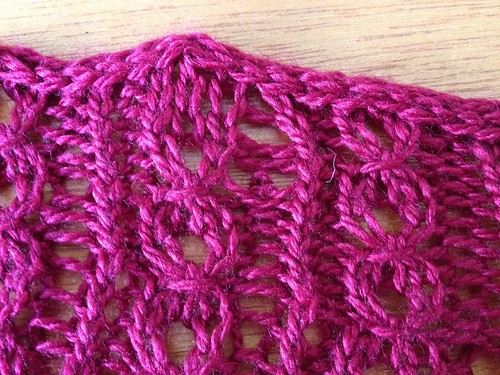
I think all of you who have ever knit lace know the feeling that hit me at that moment - suddenly and completely incapacitating panic:
OOOOOOOHSHIIIIIIIIIITTTTT!!!!!!!!!!
Thankfully I had enough functioning neurons left to take the first and most important step in a lace (or any kind of) emergency:
Step 1: take your own pulse*
Step 2 really only applies to lace emergencies: stop the drop
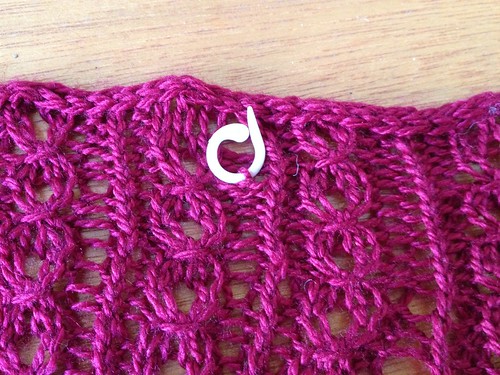
In this case, with a handy dandy split ring stitch marker. Stick it through the dropped stitch and bammo - no more dropping.
I took a few moments (ok hours) to regroup and let the shawl finish drying. Then the next step was to fix the boo boo.
Step 3: find an appropriately sized crochet hook and fix the dropped stitch.
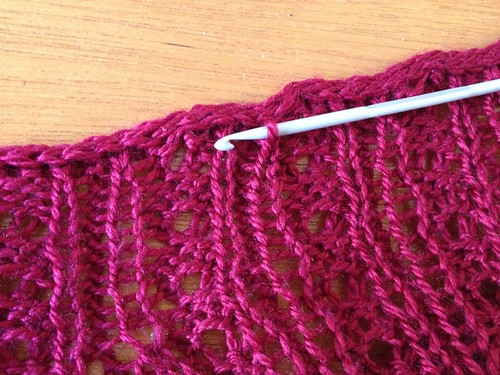
Step 4: find darned darning needle somewhere in the morass of chaos you call a desk/office/studio/room full o' wooly goodness, take a bit of leftover yarn, and secure that little barstard tight up against the i-cord bind off.
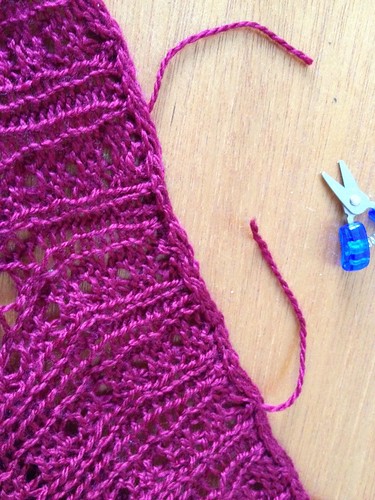
If done carefully, the result of Steps 1-4 is a invisibly repaired lace piece without having to resort to Valium and/or liters of red wine.
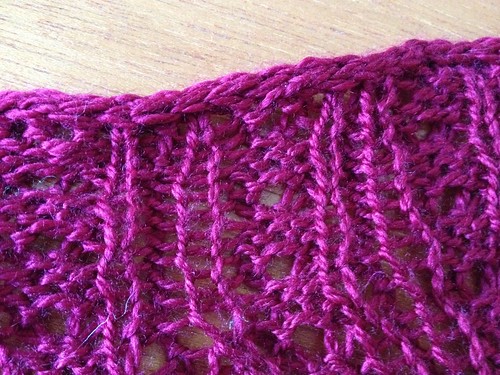
wrong side
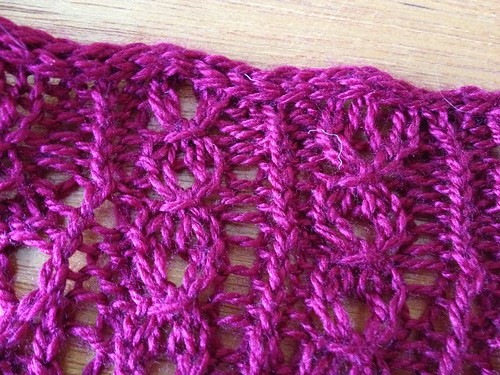
right side
I was helped in this instance by a few factors - yarn that wasn't too slippery (100% silk would have been....trickier) and a lace pattern that called for moderate blocking rather then full on Nuclear Warfare blocking. The stitch had only dropped down about 3 rows when I caught it, and there weren't any complicating lace stitches below it to screw things up. That being said, the same sort of fix can be done with more complicated and elaborate lace patterns. The key is deep breathing and going slowly.
Without further ado, my latest FO:

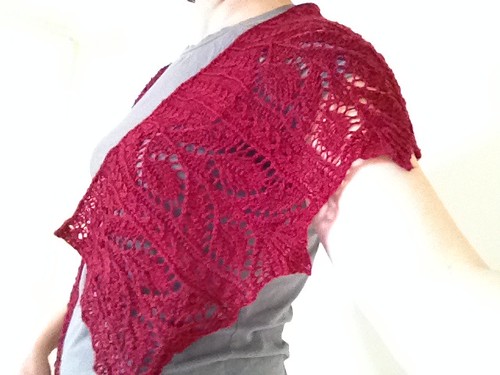

please excuse the bad pretentious iDevice selfies, but I can't find my camera anywhere
Pattern: Green the Whole Year Round by Anna Yamamoto
Yarn: Fyberspates Scrumptious 4-ply (55% merino/45% silk), 399 yds/100 g, in Cherry. My shawl weighed in at 102 g, and I still have a little bit left over, so the skein might have been a bit heavy.
Needles: US 9/5.5 mm for the cast on, US 6/4.0 mm for the rest of the shawl
Start/finish: 17 January 2014 - 1 February 2014. Knitting done by 29 January, but, you know, blocking...
Comments/modifications: I made one major modification, which was to cut out one pattern repeat to make the shawl slightly smaller. I was worried I was going to run out of yarn (it calls for a full skein of sock yarn, so 440+ yds) and my yarn was slightly heavier, so I figured it would still end up big enough. The final dimensions of my shawl are 16 in deep at the middle and just over 50 in long, so about the same size as the original pattern.
Now for the comments portion of the evening: since doing more tech editing I find myself incapable of reading patterns without a running (usually waaaaaay more snarky then necessary) internal monologue. I try to keep this to a minimum, particularly with a lovely pattern like this which is provided for free. But sometimes I can't help it. I had two major problems with this pattern:
1) the designer includes charts AND written directions for every single line of the lace pattern, WHICH IS FANTASTIC! However, the symbols used in the charts were not ones with which I was familiar. The biggest brain cramp for me was that the symbol that I usually associate with a knit stitch (a blank square) was, in this pattern, the symbol for a purl stitch. Cue headache...
2) Problem 1 was exacerbated by the fact hat I didn't find the key to the charts until I was doing the short row section of the shawl (in other words, was done with the lace section). This is because the key was on the very last page of the pattern, and not with the charts. To solve my confusion, I ended up having to go back and forth between the written directions and the chart to decipher the symbols.
So really, these two problems were mostly on my head, for not hunting harder for the chart key, but I also think that they could have been avoided by putting the key with the charts. /end grumpy porpoise
The pattern is otherwise very well written and put together, and the final shawl is gorgeous. As soon as I get my act together it will get packaged up to off to it's recipient.
And now that it's finished, I can get back to my Unravel sweater...how's everybody else doing with theirs?
* When I was teaching newbie Ski Patrollers in college, this was A Real Thing. Just the act of stopping to take your own vital signs is enough to stop the freeze up that can happen in critical situations.
You know what I'm talking about. It.
The dropped stitch:

I think all of you who have ever knit lace know the feeling that hit me at that moment - suddenly and completely incapacitating panic:
OOOOOOOHSHIIIIIIIIIITTTTT!!!!!!!!!!
Thankfully I had enough functioning neurons left to take the first and most important step in a lace (or any kind of) emergency:
Step 1: take your own pulse*
Step 2 really only applies to lace emergencies: stop the drop

In this case, with a handy dandy split ring stitch marker. Stick it through the dropped stitch and bammo - no more dropping.
I took a few moments (ok hours) to regroup and let the shawl finish drying. Then the next step was to fix the boo boo.
Step 3: find an appropriately sized crochet hook and fix the dropped stitch.

Step 4: find darned darning needle somewhere in the morass of chaos you call a desk/office/studio/room full o' wooly goodness, take a bit of leftover yarn, and secure that little barstard tight up against the i-cord bind off.

If done carefully, the result of Steps 1-4 is a invisibly repaired lace piece without having to resort to Valium and/or liters of red wine.

wrong side

right side
I was helped in this instance by a few factors - yarn that wasn't too slippery (100% silk would have been....trickier) and a lace pattern that called for moderate blocking rather then full on Nuclear Warfare blocking. The stitch had only dropped down about 3 rows when I caught it, and there weren't any complicating lace stitches below it to screw things up. That being said, the same sort of fix can be done with more complicated and elaborate lace patterns. The key is deep breathing and going slowly.
Without further ado, my latest FO:



please excuse the bad pretentious iDevice selfies, but I can't find my camera anywhere
Pattern: Green the Whole Year Round by Anna Yamamoto
Yarn: Fyberspates Scrumptious 4-ply (55% merino/45% silk), 399 yds/100 g, in Cherry. My shawl weighed in at 102 g, and I still have a little bit left over, so the skein might have been a bit heavy.
Needles: US 9/5.5 mm for the cast on, US 6/4.0 mm for the rest of the shawl
Start/finish: 17 January 2014 - 1 February 2014. Knitting done by 29 January, but, you know, blocking...
Comments/modifications: I made one major modification, which was to cut out one pattern repeat to make the shawl slightly smaller. I was worried I was going to run out of yarn (it calls for a full skein of sock yarn, so 440+ yds) and my yarn was slightly heavier, so I figured it would still end up big enough. The final dimensions of my shawl are 16 in deep at the middle and just over 50 in long, so about the same size as the original pattern.
Now for the comments portion of the evening: since doing more tech editing I find myself incapable of reading patterns without a running (usually waaaaaay more snarky then necessary) internal monologue. I try to keep this to a minimum, particularly with a lovely pattern like this which is provided for free. But sometimes I can't help it. I had two major problems with this pattern:
1) the designer includes charts AND written directions for every single line of the lace pattern, WHICH IS FANTASTIC! However, the symbols used in the charts were not ones with which I was familiar. The biggest brain cramp for me was that the symbol that I usually associate with a knit stitch (a blank square) was, in this pattern, the symbol for a purl stitch. Cue headache...
2) Problem 1 was exacerbated by the fact hat I didn't find the key to the charts until I was doing the short row section of the shawl (in other words, was done with the lace section). This is because the key was on the very last page of the pattern, and not with the charts. To solve my confusion, I ended up having to go back and forth between the written directions and the chart to decipher the symbols.
So really, these two problems were mostly on my head, for not hunting harder for the chart key, but I also think that they could have been avoided by putting the key with the charts. /end grumpy porpoise
The pattern is otherwise very well written and put together, and the final shawl is gorgeous. As soon as I get my act together it will get packaged up to off to it's recipient.
And now that it's finished, I can get back to my Unravel sweater...how's everybody else doing with theirs?
* When I was teaching newbie Ski Patrollers in college, this was A Real Thing. Just the act of stopping to take your own vital signs is enough to stop the freeze up that can happen in critical situations.